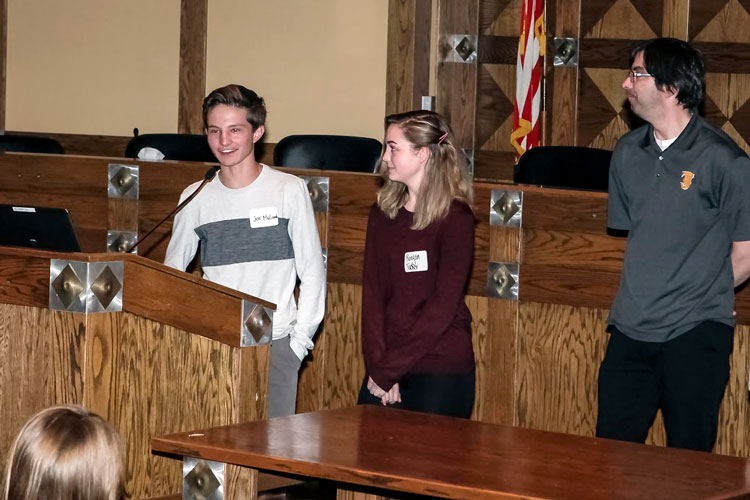
Joe McComb answers the audience's questions about how Citizen Science can be beneficial for students. photo courtesy of Scott Esser
Spartans participate in an environmental conference shaping Rocky Mountain National Park.
On March 1st, 2017, Estes Park Town Hall hosted a biennial research conference dedicated to bettering Rocky Mountain National Park through findings and ideas. A plethora of scientists, professors, and teachers presented their environmental related work through presentations viewed by townspeople and other spectators who were intrigued by the variety of topics. This was AP Environmental Science teacher Brett Butera’s first time presenting at the conference; his topic covered integrating Citizen Science into a high school science curriculum. He had been asked to present by ecologist Scott Esser in order to spread awareness about Citizen Science. To bring more meaning to his presentation, two AP Environmental Science students, sophomores Joe McComb and Reagan Tucker, spoke about their experiences with Citizen Science, which they had participated in during a field trip to Rocky Mountain National Park in October 2016.
All the presenters focused on different topics that had one thing in common: how Citizen Science can help to reshape an ecosystem. Citizen Science is a program encouraging educators and parks people to get school age kids involved in ecology, allowing them to conduct experiments in a forest environment in order to gather data that will later be used to help the park. Butera’s presentation went in detail about the educational aspect of Citizen Science. He mentioned resources he developed to use as a prerequisite stating, “I discussed how I taught forest ecology field research skills, data analysis skills, and forest ecology lessons at TJ to prepare my students for an excursion to RMNP, in which they would conduct field research to collect forest ecology data.” The presentation shaped Butera and showed him just how fortunate he was to partake in such a renowned scientific research conference while being surrounded by respected researchers and educators. Butera claimed, “Citizen science is a research tool that can provide insightful data to inform management decisions, while also serving to enhance ecological awareness and foster the development of environmental stewardship among participants.” Adding a level of authenticity to the presentation, McComb described his experience as, “Enabling me to think differently about the environment around me and showing me how to preserve the world around me for future generations.”
Professor Ashley D’Antonio studies nature-based recreation management and recreation ecology at Oregon State University. Her presentation at the conference encompassed the ecological impacts that bouldering activities were having in the Bear Lake area of Rocky Mountain National Park. D’Antonio stated, “I learn new things every time I attend these conferences. My research is very focused on recreation and by attending the conference I was able to learn new things that I do not hear about very often in my field, topics like anthropology and wildlife disease.”
Professor Scott Williams teaches at the University of Northern Colorado, and his presentation focused on clonal plant responses to disturbance in the Tatras in Central Europe with the hopes that scientists and the public would begin to take notice of and spread awareness through word of mouth. By using Citizen Science, Williams is able to obtain more information on this topic through student help and introduce his students to a more professional scientific setting covering real problems and finding a solution.
Dr. Diana F. Tomback’s laboratory master’s student Tyler Williams studies at CU Denver- his presentation was fixated on his graduate research. His studies were comprised of analyzing different sized seed usage for food in Rocky Mountain National Park and what tree species will be affected, thus influencing metapopulation connectivity.
Utah State University student Robin Graham works in recreation ecology in Logan, Utah and Rocky Mountain National Park. Her presentation concentrated on how behavior and visitor use alongside topography and existing recreation related to ecological impacts in order to establish key areas to target visitor monitoring and management. Graham noted, “Studying recreation ecology has made me hyper-aware of recreation related impacts which I cannot help but notice when I am recreating during my free time. I have loved working in this field because it is ever-changing, challenging, and directly helps the conservation and management of national parks.”
Biogeochemist Jill Baron works for the U.S. Geological Survey located in Fort Collins, and her presentation explored 865 years in the life of The Loch, a subalpine lake in the park. Her data was supplied by lake sediment cores, which record changes throughout time. There was a suggested change in algae that tied back to human activity when looking at the most recent years, 1850 to present day. Baron mentioned, “Science is a process, not a product, and it provides a tool of discovery.”
The 2017 biennial Rocky Mountain Research Conference was successful in the sense that new data was shared in order to better the park for future generations while getting them involved. Without the dedication and extensive work from these, and many other, scientists and educators, as well as students, the park would not be what it is today, or what it will eventually become. If the Citizen Science program is used as Butera and many others proposed, progress can be made towards a better future for the environment.